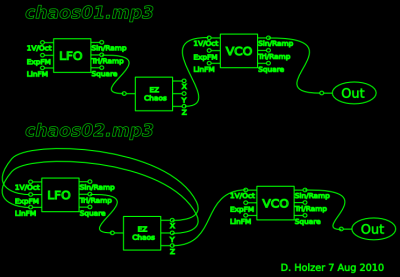Testing for Chaos
The following are tests of the chaotic synthesis system I’m working on, and in no way should be considered “finished pieces”:
Modules used in these recordings:
Thomas Henry XR-2206 VCO (Bugbrand PCB layout)(VCO range)
Thomas Henry XR-2206 VCO (Bugbrand PCB layout)(LFO range)
Ian Fritz EZ Chaos (Uncle Krunkus stripboard layout)
In the first example, chaos01.mp3, the triangle waveform of the LFO drives the EZ Chaos. The Z (marked NL on schematic) output of the EZ Chaos drives the 1V/Oct input of the VCO. Both Drive and Rate pots are set about at the middle, and the Damping is totally turned down. As you can hear, it maintains a very steady modulation. The changes in modulation pattern only come from my manually adjusting the LFO.
In the second example, chaos02.mp3, the poti settings and routing remain the same from chaos01.mp3. However, I have routed the Y output to the Linear FM of the LFO, and the X output to the Exponential FM of the LFO. The modulations become much more chaotic in this setup. Through the clip, I adjust the depth of the LinFM, ExpFM and the general rate of the LFO. Better, don’t you think?
For me, the modulation patterns in chaos01.mp3 sound to me like a non-linear transfer function, but don’t sound chaotic at all in the sense that the transfer function remains almost identical for every cycle of the LFO at any frequency tested.
My understanding of chaotic synthesis usually involves feedback between at least two–but in my experiments up to 8–cross-modulated VCOs with a non-linear function in the feedback loop. The results tend towards certain attractors, but every cycle is distinct from the previous one, even if after 3 or 7 or 15 cycles you might return to a common origin.
Assuming that my EZ Chaos circuit functions as it should, the benefit I see out of it would be the ability to make chaotic patterns from a single LFO through the feedback. Normally I would have to use 2 or more LFOs to get the same kind of chaotic oscillations.
However, by itself I don’t hear chaos coming from this circuit, only non-linearity. It’s the feedback in chaos02.mp3 that makes it chaotic for me. Looking at a double well attractor on the scope is one thing, but hearing it is the proof…
Updated info on the chaos circuit as well as some tuning tips can be found on the Elby Designs page for their ED108-ChaQuO module.
Tags: audio, chaos, synthesizer